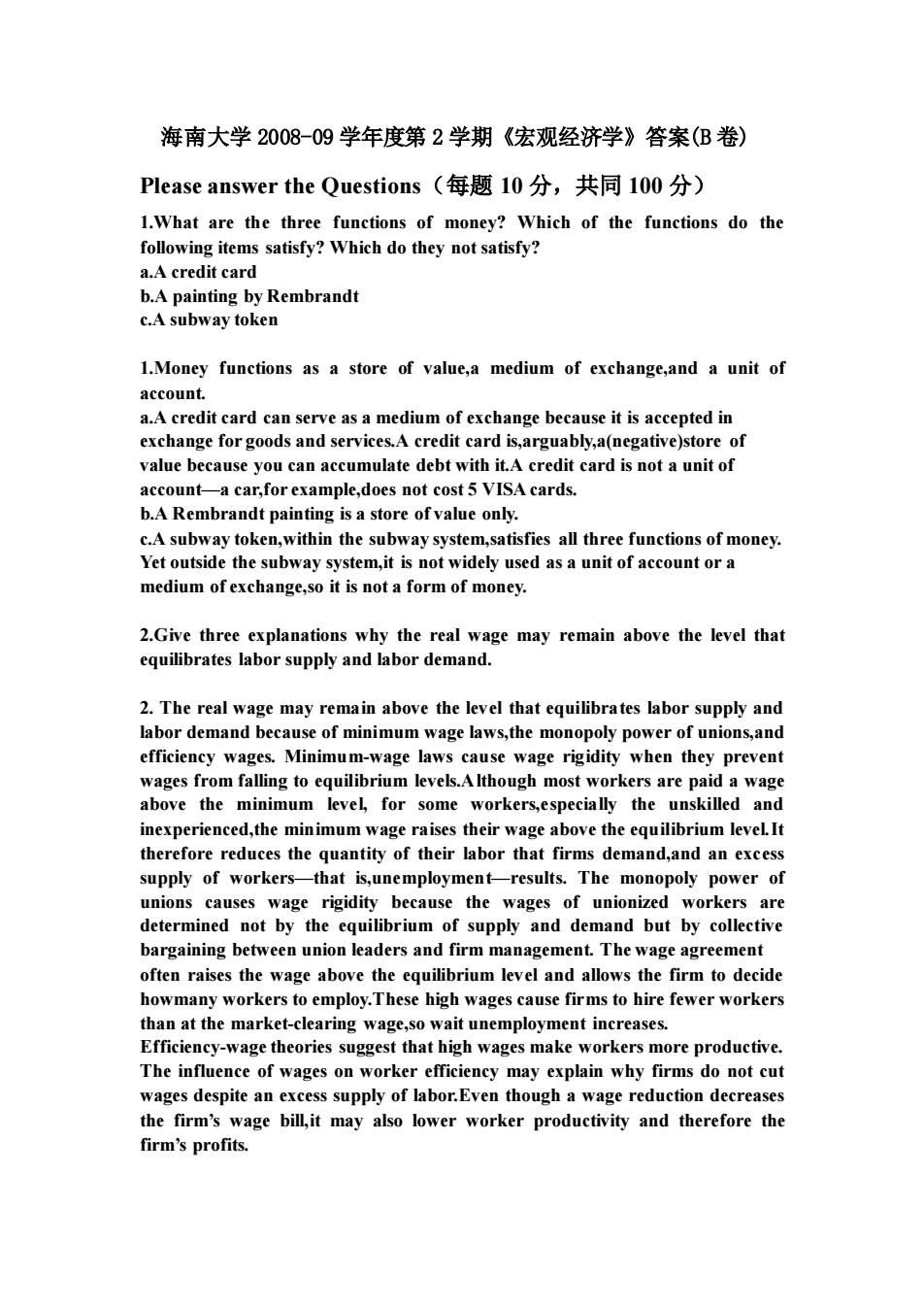
海南大学2008-09学年度第2学期《宏观经济学》答案(B卷) Please answer the Questions(每题10分,共同100分) 1.What are the three functions of money?Which of the functions do the following items satisfy?Which do they not satisfy? a.A credit card b.A painting by Rembrandt c.A subway token 1.Money functions as a store of value,a medium of exchange,and a unit of account. a.A credit card can serve as a medium of exchange because it is accepted in exchange for goods and services.A credit card is,arguably,a(negative)store of value because you can accumulate debt with it.A credit card is not a unit of account-a car,for example,does not cost 5 VISA cards. b.A Rembrandt painting is a store of value only. c.A subway t token,within the sub way syst ,satisfies all three functions of money. Yet outside the subway system,it is not widely used as a unit of account or a medium of exchange,so it is not a form of money. 2.Give three explanations why the real wage may remain above the level that equilibrates labor supply and labor demand. 2.The real wage may remain above the level that equilibrates labor supply and labor demand because of minimum wage laws,the monopoly power of unions,and efficiency wages.Minimum-wage laws cause wage rigidity when they prevent g to equilibriu m levels.A lthough workers are pai d wage mini mum level,for some workers,especiall unskilled and inexperienced,the minimum wage raises their wage above the equilibrium leveL It therefore reduces the quantity of their labor that firms demand,and an excess workers-that is,unemployment-results.The monopoly ons eauses wage rigidity because the wages of unionized orkers are mined not by the supply and de nd but by collecti bargaining between union leaders and firm management.The wage agreement often raises the wage above the equilibrium level and allows the firm to decide howmany workers to employ.These high wages cause firms to hire fewer workers than at the market-clearing wage,so wait unemployment increases. Efficier wage the est that high more productive. The influence of wages on worker efficieney may explain why firms do not cu wages despite an excess supply of labor.Even though a wage reduction decreases the firm's wage bill,it may also lower worker productivity and therefore the firm's profits
海南大学 2008-09 学年度第 2 学期《宏观经济学》答案(B 卷) Please answer the Questions(每题 10 分,共同 100 分) 1.What are the three functions of money? Which of the functions do the following items satisfy? Which do they not satisfy? a.A credit card b.A painting by Rembrandt c.A subway token 1.Money functions as a store of value,a medium of exchange,and a unit of account. a.A credit card can serve as a medium of exchange because it is accepted in exchange for goods and services.A credit card is,arguably,a(negative)store of value because you can accumulate debt with it.A credit card is not a unit of account—a car,for example,does not cost 5 VISA cards. b.A Rembrandt painting is a store of value only. c.A subway token,within the subway system,satisfies all three functions of money. Yet outside the subway system,it is not widely used as a unit of account or a medium of exchange,so it is not a form of money. 2.Give three explanations why the real wage may remain above the level that equilibrates labor supply and labor demand. 2. The real wage may remain above the level that equilibrates labor supply and labor demand because of minimum wage laws,the monopoly power of unions,and efficiency wages. Minimum-wage laws cause wage rigidity when they prevent wages from falling to equilibrium levels.Although most workers are paid a wage above the minimum level, for some workers,especially the unskilled and inexperienced,the minimum wage raises their wage above the equilibrium level.It therefore reduces the quantity of their labor that firms demand,and an excess supply of workers—that is,unemployment—results. The monopoly power of unions causes wage rigidity because the wages of unionized workers are determined not by the equilibrium of supply and demand but by collective bargaining between union leaders and firm management. The wage agreement often raises the wage above the equilibrium level and allows the firm to decide howmany workers to employ.These high wages cause firms to hire fewer workers than at the market-clearing wage,so wait unemployment increases. Efficiency-wage theories suggest that high wages make workers more productive. The influence of wages on worker efficiency may explain why firms do not cut wages despite an excess supply of labor.Even though a wage reduction decreases the firm’s wage bill,it may also lower worker productivity and therefore the firm’s profits
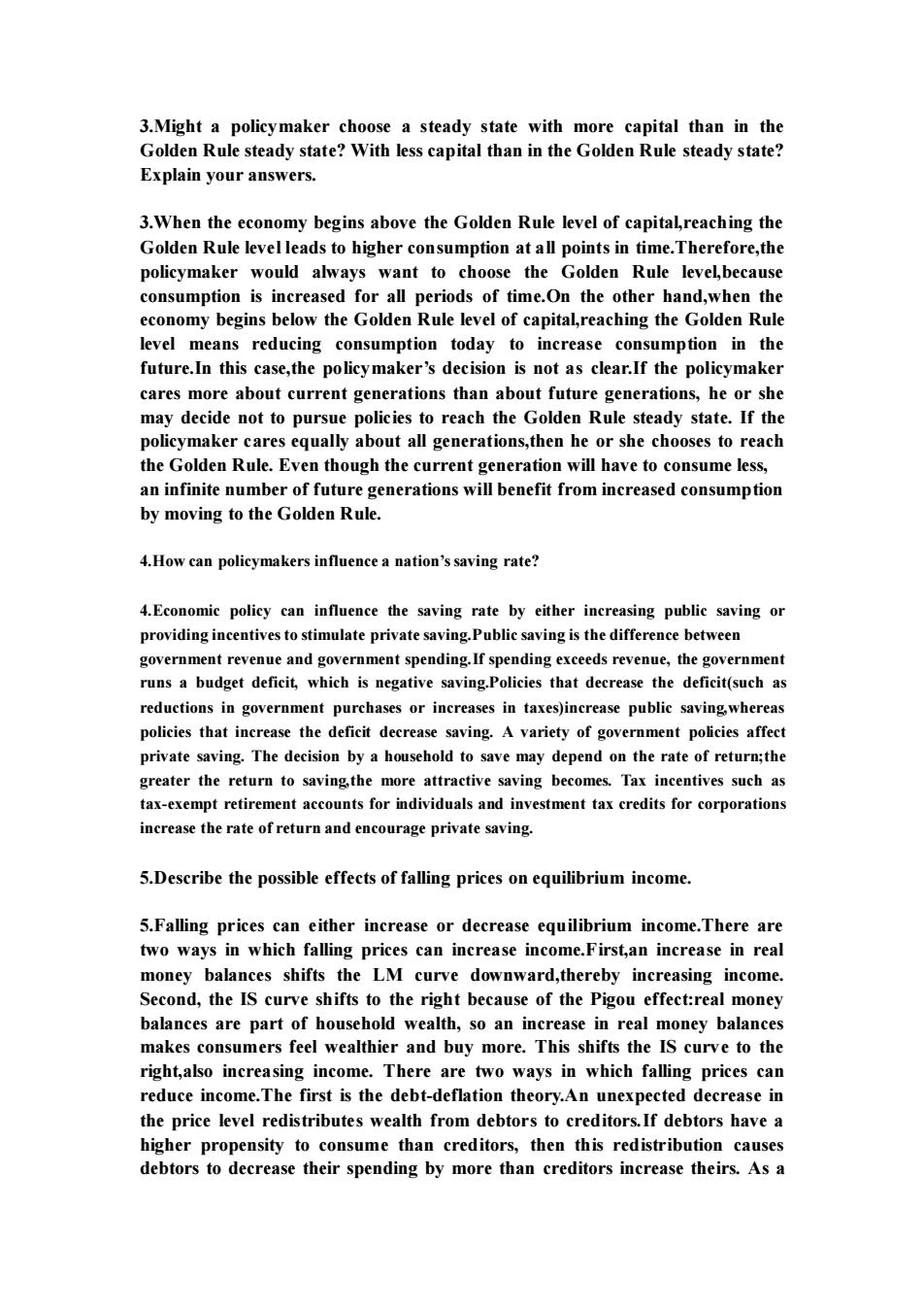
3.Might a policymaker choose a steady state with more capital than in the Golden Rule steady state?With less capital than in the Golder Rule steady state? Explain your answers. 3.When the economy begins above the golden rule level of capitaLreaching the Golden Rule level leads to higher consumption at all points in time.Therefore,the policymaker ould alw ant to choc ose the Golden Rule level,be cause consumption is rease .0 the othe when th economy begins below the Golden Rule level of capital,reaching the Golden Rul level means reducing consumption today to increase consumption in the future.In this case,the policymaker's decision is not as clear.If the policymaker cares more about current generations than about future generations,he or she decide not to pursu e policies o reach the Golden Rule stea dy state.If the policymaker cares equally about all generations,then he or she chooses to reach the Golden Rule.Even though the current generation will have to consume less, an infinite number of future generations will benefit from increased consumption by moving to the Golden Rule. 4.How can policymakers influence a nation's saving rate? 4.Economic policy can influence the saving rate by either increasing public saving or providing incentives to stimulate private saving.Public saving is the difference between nent spending.If spending exceeds revenue,the government ving policies as the reductions in government purchases or increases in taxes)increase public saving,whereas policies that increase the deficit decrease saving.A variety of government policies affect private saving.The decision by a household to save may depend on the rate of return;the greater the return to saving,the more attractive saving becomes.Tax incentives such as -exempt retir ment accc unts for individuals and inve nt tax credits for corporation increase the rate of return and encourage private saving 5.Describe the possible effects of falling prices on equilibrium income. 5.Falling prices can either increase or decrease equilibrium income.There are two ways in which falling es can increase income.First,an increase in rea money balances shifts the LM curve downward,thereby increasing income Second,the IS curve shifts to the right because of the Pigou effect:real money balances are part of household wealth,so an increase in real money balances makes consume ers feel wealthier and buy more.This shifts the IS curve to the right,also incre ays in which fallin g prices ca reduce income.The first is the debt-deflation theory.An unexpected decrease in the price level redistributes wealth from debtors to creditors.If debtors have a higher propensity to consume than creditors,then this redistribution causes debtors to decrease their spending by more than creditors increase theirs.As a
3.Might a policymaker choose a steady state with more capital than in the Golden Rule steady state? With less capital than in the Golden Rule steady state? Explain your answers. 3.When the economy begins above the Golden Rule level of capital,reaching the Golden Rule level leads to higher consumption at all points in time.Therefore,the policymaker would always want to choose the Golden Rule level,because consumption is increased for all periods of time.On the other hand,when the economy begins below the Golden Rule level of capital,reaching the Golden Rule level means reducing consumption today to increase consumption in the future.In this case,the policymaker’s decision is not as clear.If the policymaker cares more about current generations than about future generations, he or she may decide not to pursue policies to reach the Golden Rule steady state. If the policymaker cares equally about all generations,then he or she chooses to reach the Golden Rule. Even though the current generation will have to consume less, an infinite number of future generations will benefit from increased consumption by moving to the Golden Rule. 4.How can policymakers influence a nation’s saving rate? 4.Economic policy can influence the saving rate by either increasing public saving or providing incentives to stimulate private saving.Public saving is the difference between government revenue and government spending.If spending exceeds revenue, the government runs a budget deficit, which is negative saving.Policies that decrease the deficit(such as reductions in government purchases or increases in taxes)increase public saving,whereas policies that increase the deficit decrease saving. A variety of government policies affect private saving. The decision by a household to save may depend on the rate of return;the greater the return to saving,the more attractive saving becomes. Tax incentives such as tax-exempt retirement accounts for individuals and investment tax credits for corporations increase the rate of return and encourage private saving. 5.Describe the possible effects of falling prices on equilibrium income. 5.Falling prices can either increase or decrease equilibrium income.There are two ways in which falling prices can increase income.First,an increase in real money balances shifts the LM curve downward,thereby increasing income. Second, the IS curve shifts to the right because of the Pigou effect:real money balances are part of household wealth, so an increase in real money balances makes consumers feel wealthier and buy more. This shifts the IS curve to the right,also increasing income. There are two ways in which falling prices can reduce income.The first is the debt-deflation theory.An unexpected decrease in the price level redistributes wealth from debtors to creditors.If debtors have a higher propensity to consume than creditors, then this redistribution causes debtors to decrease their spending by more than creditors increase theirs. As a
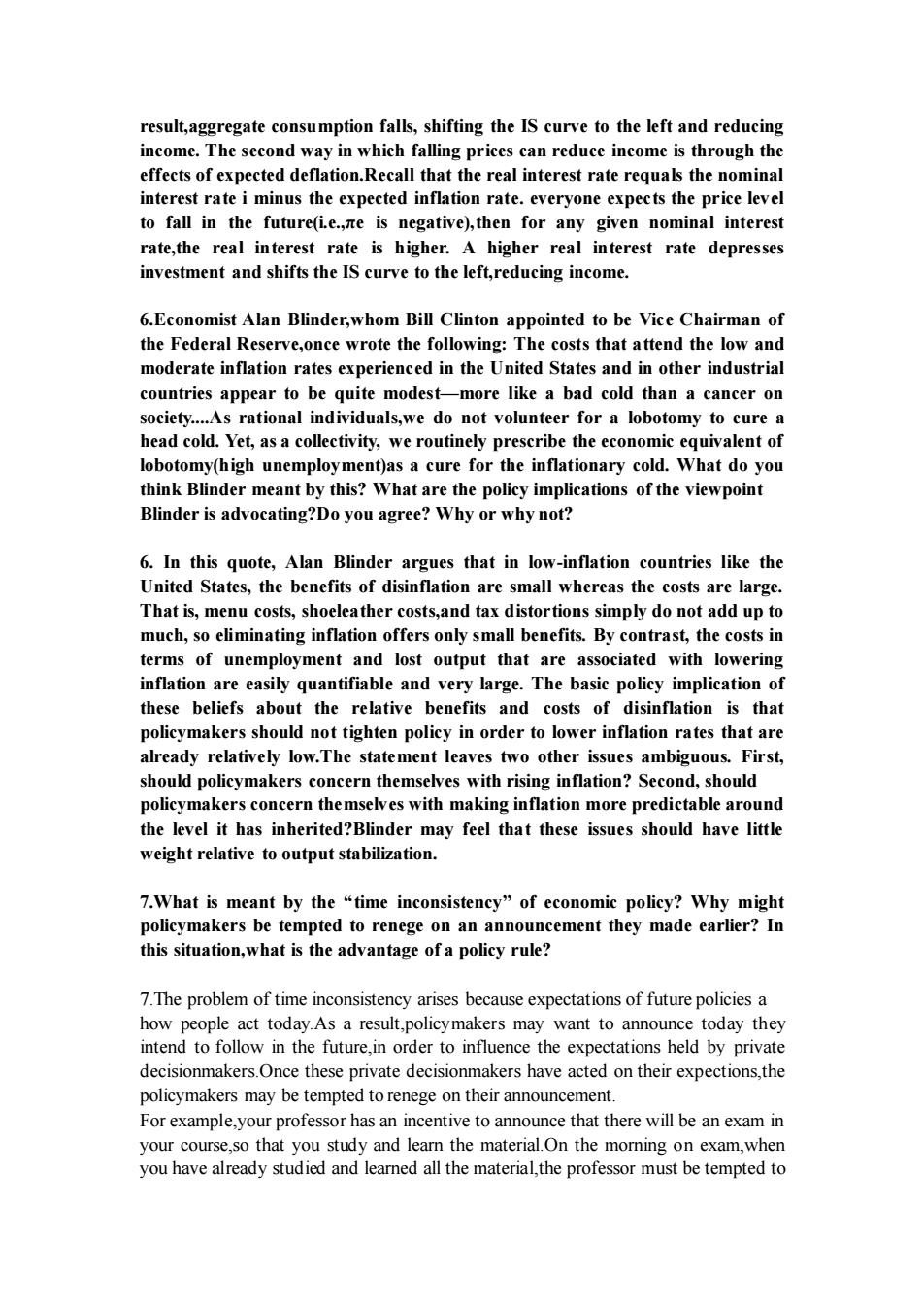
effects of expected deflation.Recall that the real interest rate requals the nominal interest rate i minus the expected inflation rate.everyone expects the price level to fall in the future(ie.,ne is negative),then for any given nominal interest rate,the real interest rate is higher.A higher real interest rate depresses investment and shifts the IS curve to the left,reducing income 6.Economist Alan Blinder,whom Bill Clinton appointed to be Vice Chairman of the Federal Reserve,once wrote the following:The costs that attend the low and moderate inflation rates experienced in the United States and in other industrial countries appear to he quite modest more like a bad cold than a cancer on society. As rational uals,we do not volunteer for a lobotomy to cure a head cold.Yet,as a collectivity,we routinely prescribe the economic equivalent of lobotomy(high unemployment)as a cure for the inflationary cold.What do you think Blinder meant by this?What are the policy implications of the viewpoint Blinder is advocating?Do you agree?Why or why not? 6.In this quote,Alan Blinder argues that in low-inflation countries like the United States,the benefits of disinflation are small whereas the costs are large. That is,menu costs,shoeleather costs,and tax distortions simply do not add up to much,so eliminating inflation offers only small benefits.By contrast,the costs in terms of unem loyment and lost outp ociated with erin inflation are easily quantifiable and very large.The basic policy implication of these beliefs about the relative benefits and costs of disinflation is that policymakers should not tighten policy in order to lower inflation rates that are already relatively low.The statement leaves two other issues ambiguous.First. should policymaker on ern themselves with risine gi nation?Sco ond,should ern the mselves with making inflation more predictable aro the level it has inherited?Blinder may feel that these issues should have little weight relative to output stabilization. 7.What is meant by the "time inconsistency"of economie policy?Why might he t ym ted renege cemen they m ade earlier?In situation,what is the advantage of a policy rule? 7 The problem of time inconsistency arises because expectations of future policies a how people act today.As a result,policymakers may want to announce today they intend to follow in the future ir der to influence the expe ectations held by decisionmakers e these private decisionmakers have acted on their expections,the policymakers may be tempted to renege on their announcement For example,your professor has an incentive to announce that there will be an exam in your course.so that you study and learn the material.On the morning on exam,when you have already studied and leared all the materialthe professor must be tempted to
result,aggregate consumption falls, shifting the IS curve to the left and reducing income. The second way in which falling prices can reduce income is through the effects of expected deflation.Recall that the real interest rate requals the nominal interest rate i minus the expected inflation rate. everyone expects the price level to fall in the future(i.e.,πe is negative),then for any given nominal interest rate,the real interest rate is higher. A higher real interest rate depresses investment and shifts the IS curve to the left,reducing income. 6.Economist Alan Blinder,whom Bill Clinton appointed to be Vice Chairman of the Federal Reserve,once wrote the following: The costs that attend the low and moderate inflation rates experienced in the United States and in other industrial countries appear to be quite modest—more like a bad cold than a cancer on society.As rational individuals,we do not volunteer for a lobotomy to cure a head cold. Yet, as a collectivity, we routinely prescribe the economic equivalent of lobotomy(high unemployment)as a cure for the inflationary cold. What do you think Blinder meant by this? What are the policy implications of the viewpoint Blinder is advocating?Do you agree? Why or why not? 6. In this quote, Alan Blinder argues that in low-inflation countries like the United States, the benefits of disinflation are small whereas the costs are large. That is, menu costs, shoeleather costs,and tax distortions simply do not add up to much, so eliminating inflation offers only small benefits. By contrast, the costs in terms of unemployment and lost output that are associated with lowering inflation are easily quantifiable and very large. The basic policy implication of these beliefs about the relative benefits and costs of disinflation is that policymakers should not tighten policy in order to lower inflation rates that are already relatively low.The statement leaves two other issues ambiguous. First, should policymakers concern themselves with rising inflation? Second, should policymakers concern themselves with making inflation more predictable around the level it has inherited?Blinder may feel that these issues should have little weight relative to output stabilization. 7.What is meant by the “time inconsistency’’ of economic policy? Why might policymakers be tempted to renege on an announcement they made earlier? In this situation,what is the advantage of a policy rule? 7.The problem of time inconsistency arises because expectations of future policies a how people act today.As a result,policymakers may want to announce today they intend to follow in the future,in order to influence the expectations held by private decisionmakers.Once these private decisionmakers have acted on their expections,the policymakers may be tempted to renege on their announcement. For example,your professor has an incentive to announce that there will be an exam in your course,so that you study and learn the material.On the morning on exam,when you have already studied and learned all the material,the professor must be tempted to
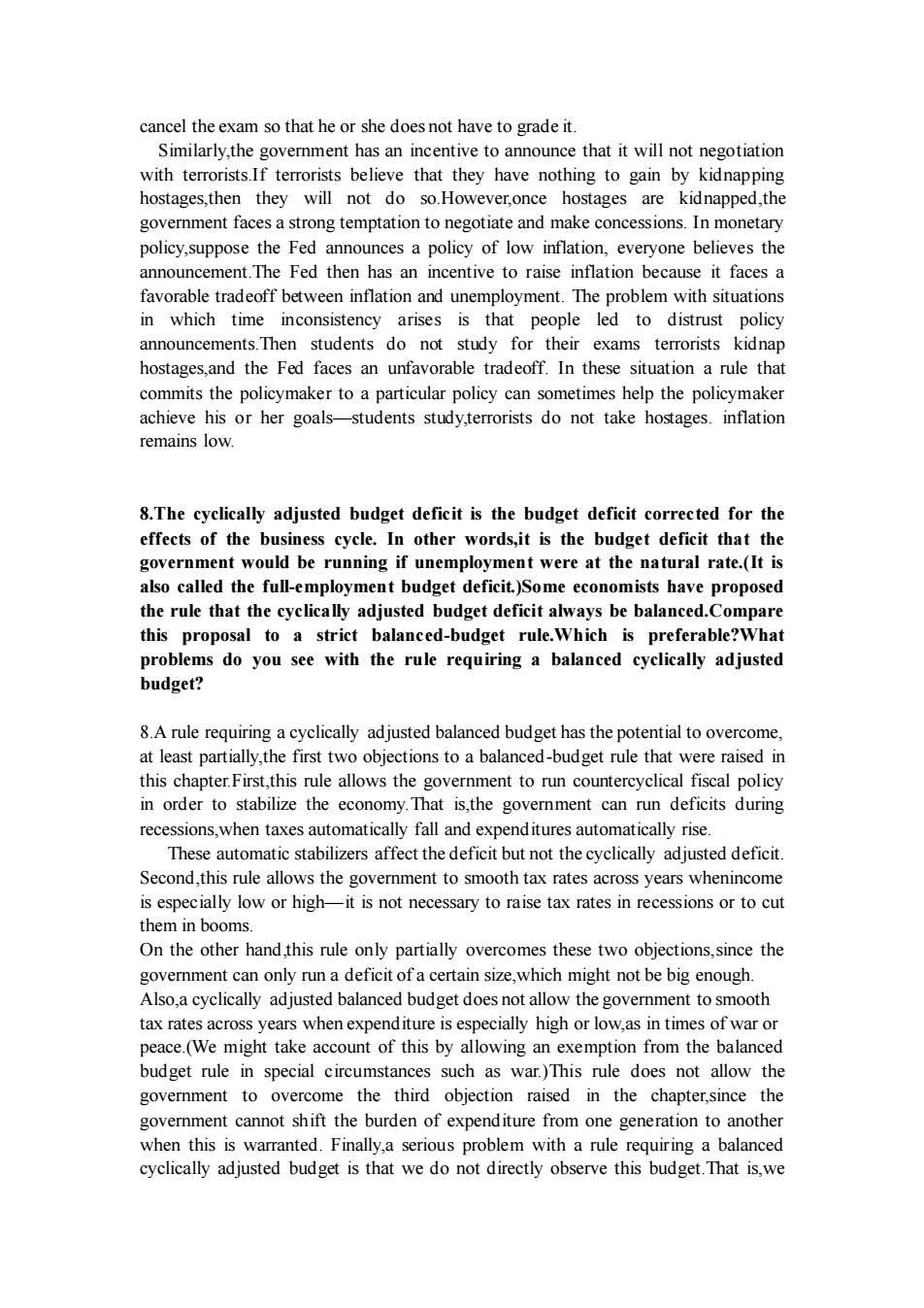
cancel the exam so that he or she does not have to grade it. Similarly,the ithtenoitsifg an inc e that it will not negotiation ts believe that they have nothing to gain by kidnapping hostages,then they will not do so.However,once hostages are kidnapped,the government faces a strong temptation to negotiate and make concessions.In monetary policy,suppose the Fed announces a policy of low inflation,everyone believes the noun nt The Fed then s an tive to raise inflation ause it faces off between inflation and unemployment.The prob em with situat in which time inconsistency arises is that people led to distrust policy announcements.Then students do not study for their exams terrorists kidnap hostages,and the Fed faces an unfavorable tradeoff.In these situation a rule that commits the policymaker to a particular policy can sometimes help the policymaker achieve his or her goals -students study terrorists do not take hostages.inflatior remains lov 8.The cyclically adjusted budget deficit is the budget deficit corrected for the effects of the bu ess cycl other words,it is the budget deficit that the governn would be running if unemployment were at the natural rate.(It is also called the full-employment budget deficit.)Some economists have proposed the rule that the cyclically adjusted budget deficit always be balanced.Compare this proposal to a strict balanced-budget rule.Which is preferable?What pro do you se with the rule requiringa balanced cvclically adjusted 8.A rule requiring a cyclically adjusted balanced budget has the potential to overcome. at least partially,the first two objections to a balanced-budget rule that were raised in this chapter.First,this rule allows the government to run countercyclical fiscal policy in order to stabilize the ec That is.the 1 deficits recessions,when taxes automatically fall and expenditures automati cally rise These automatic stabilizers affect the deficit but not the cyclically ad justed deficit Second,this rule allows the government to smooth tax rates across years whenincome is especially low or high- -it is not necessary to raise tax rates in recessions or to cut them in booms n the other handthis rule only partially these two objections,sinc the government can only run a deficit of a certain size which might not be big enough Also,a cyclically adjusted balanced budget does not allow the government to smooth tax rates across vears when expenditure is especially high or low as in times of war or peace.(We might take account of this by allowing an exemption from the balanced budget rule special wa )Thi doe not allow the govemment toverom the third bctionthchaptinch government cannot shift the burden of expenditure from one generation to another when this is warranted.Finally,a serious problem with a rule requiring a balanced cyclically adjusted budget is that we do not directly observe this budget.That is.we
cancel the exam so that he or she does not have to grade it. Similarly,the government has an incentive to announce that it will not negotiation with terrorists.If terrorists believe that they have nothing to gain by kidnapping hostages,then they will not do so.However,once hostages are kidnapped,the government faces a strong temptation to negotiate and make concessions. In monetary policy,suppose the Fed announces a policy of low inflation, everyone believes the announcement.The Fed then has an incentive to raise inflation because it faces a favorable tradeoff between inflation and unemployment. The problem with situations in which time inconsistency arises is that people led to distrust policy announcements.Then students do not study for their exams terrorists kidnap hostages,and the Fed faces an unfavorable tradeoff. In these situation a rule that commits the policymaker to a particular policy can sometimes help the policymaker achieve his or her goals—students study,terrorists do not take hostages. inflation remains low. 8.The cyclically adjusted budget deficit is the budget deficit corrected for the effects of the business cycle. In other words,it is the budget deficit that the government would be running if unemployment were at the natural rate.(It is also called the full-employment budget deficit.)Some economists have proposed the rule that the cyclically adjusted budget deficit always be balanced.Compare this proposal to a strict balanced-budget rule.Which is preferable?What problems do you see with the rule requiring a balanced cyclically adjusted budget? 8.A rule requiring a cyclically adjusted balanced budget has the potential to overcome, at least partially,the first two objections to a balanced-budget rule that were raised in this chapter.First,this rule allows the government to run countercyclical fiscal policy in order to stabilize the economy.That is,the government can run deficits during recessions,when taxes automatically fall and expenditures automatically rise. These automatic stabilizers affect the deficit but not the cyclically adjusted deficit. Second,this rule allows the government to smooth tax rates across years whenincome is especially low or high—it is not necessary to raise tax rates in recessions or to cut them in booms. On the other hand,this rule only partially overcomes these two objections,since the government can only run a deficit of a certain size,which might not be big enough. Also,a cyclically adjusted balanced budget does not allow the government to smooth tax rates across years when expenditure is especially high or low,as in times of war or peace.(We might take account of this by allowing an exemption from the balanced budget rule in special circumstances such as war.)This rule does not allow the government to overcome the third objection raised in the chapter,since the government cannot shift the burden of expenditure from one generation to another when this is warranted. Finally,a serious problem with a rule requiring a balanced cyclically adjusted budget is that we do not directly observe this budget.That is,we
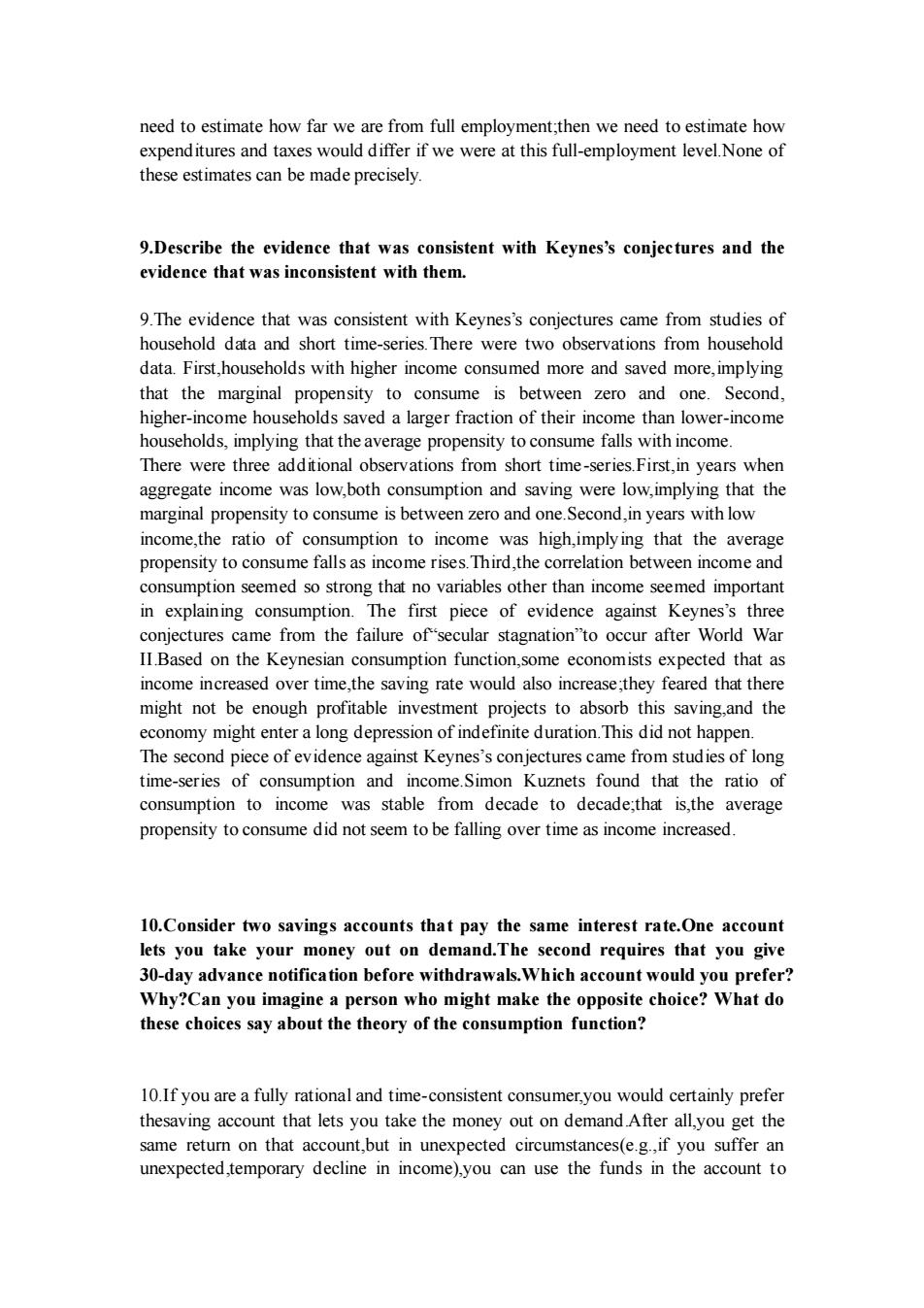
need to estimate how far we are from full employment then we need to estimate how and taxes would fer if we were at this full-employment leve Noe these estimates can be made precisely 9.Describe the evidence that was consistent with Keynes's conjectures and the evidence that was inconsistent with them 9.The evidence that was consistent with Keynes's conjectures came from studies of household data and short time-series.There were two observations from household data.First,households with higher income consumed more and saved more.implying that the marginal propensity to consume is betwee zero and one higher-income h eholds saved a larger fraction of their inc ne tha n lower-Income households,implying that the average propensity to consume falls with income. There were three additional observations from short time-series.First,in years when aggregate income was low,both consumption and saving were low,implying that the arginal propensity toconsume is,in ye swith low income,the ratio of cor sumption to incon wa high,implying that the averag propensity to consume falls as income rises.Ihird,the correlation between income and consumption seemed so strong that no variables other than income seemed important in explaining consumption.The first piece of evidence against Keynes's three conjectures came from the failure of'secular stagnation"to occur after World War II.Base K mption funct expected that as income increased over time,the saving rate would also increase:they feared that there might not be enough profitable investment projects to absorb this saving and the economy might enter a long depression of indefinite duration.This did not happen. The second piece of evidence against Keynes's conjectures came from studies of long of cor and incor me.Simor ets fo und that the ratio of consumption to incom was stable decade to decad is,the propensity to consume did not seem to be falling over time as income increased 10.Consider two savings accounts that pay the same interest rate.One accoun lets you take your money out on demand.The second requires that yougve 30-day advance notification before withdrawals.Which account would you prefer? Why?Can you imagine a person who might make the opposite choice?What do these choices say about the theory of the consumption function? 10.If you are a fully rational and time-consistent consumer,you would certainly prefer thesaving account that lets you take the money out on demand After all,you get the same return on that account but in unexpected circumstances(e.g.if you suffer an unexpected,temporary decline in income).you can use the funds in the account to
need to estimate how far we are from full employment;then we need to estimate how expenditures and taxes would differ if we were at this full-employment level.None of these estimates can be made precisely. 9.Describe the evidence that was consistent with Keynes’s conjectures and the evidence that was inconsistent with them. 9.The evidence that was consistent with Keynes’s conjectures came from studies of household data and short time-series.There were two observations from household data. First,households with higher income consumed more and saved more,implying that the marginal propensity to consume is between zero and one. Second, higher-income households saved a larger fraction of their income than lower-income households, implying that the average propensity to consume falls with income. There were three additional observations from short time-series.First,in years when aggregate income was low,both consumption and saving were low,implying that the marginal propensity to consume is between zero and one.Second,in years with low income,the ratio of consumption to income was high,implying that the average propensity to consume falls as income rises.Third,the correlation between income and consumption seemed so strong that no variables other than income seemed important in explaining consumption. The first piece of evidence against Keynes’s three conjectures came from the failure of“secular stagnation”to occur after World War II.Based on the Keynesian consumption function,some economists expected that as income increased over time,the saving rate would also increase;they feared that there might not be enough profitable investment projects to absorb this saving,and the economy might enter a long depression of indefinite duration.This did not happen. The second piece of evidence against Keynes’s conjectures came from studies of long time-series of consumption and income.Simon Kuznets found that the ratio of consumption to income was stable from decade to decade;that is,the average propensity to consume did not seem to be falling over time as income increased. 10.Consider two savings accounts that pay the same interest rate.One account lets you take your money out on demand.The second requires that you give 30-day advance notification before withdrawals.Which account would you prefer? Why?Can you imagine a person who might make the opposite choice? What do these choices say about the theory of the consumption function? 10.If you are a fully rational and time-consistent consumer,you would certainly prefer thesaving account that lets you take the money out on demand.After all,you get the same return on that account,but in unexpected circumstances(e.g.,if you suffer an unexpected,temporary decline in income),you can use the funds in the account to
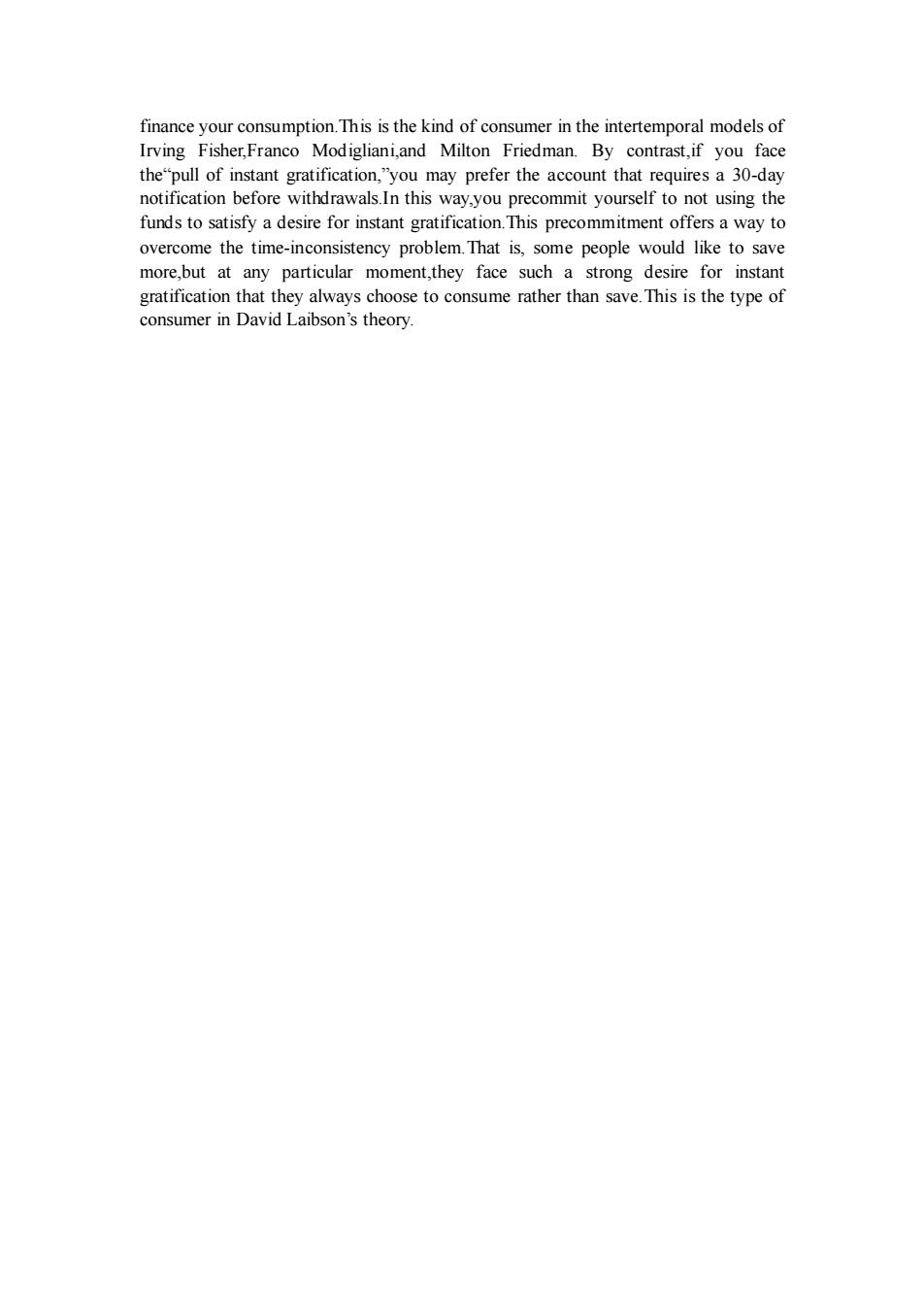
finance your consumption.This is the kind of consumer in the intertemporal models of Fisher,Franco Modigliani,and Milton Friedman. By contrast,if you face thepull of instant gratification,"you may prefer the account that requires a 30-day notification before withdrawals.In this way.you precommit yourself to not using the funds to satisfy a desire for instant gratification.This precommitment offers a way to overcome the time-inconsistency problem.That is,some people would like to save more,but at a oment,they face such a desire for they always choose to consume rather than save.This is the type of consumer in David Laibson's theory
finance your consumption.This is the kind of consumer in the intertemporal models of Irving Fisher,Franco Modigliani,and Milton Friedman. By contrast,if you face the“pull of instant gratification,”you may prefer the account that requires a 30-day notification before withdrawals.In this way,you precommit yourself to not using the funds to satisfy a desire for instant gratification.This precommitment offers a way to overcome the time-inconsistency problem.That is, some people would like to save more,but at any particular moment,they face such a strong desire for instant gratification that they always choose to consume rather than save.This is the type of consumer in David Laibson’s theory